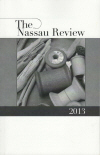The Nassau Review – 2013
The 2013 issue of The Nassau Review revolves around the theme of “Ekphrasis” or descriptions of other works of art. Each piece in this issue stays true to the theme and gives the reader things to think about on multiple levels. The work in the journal will make the reader not only contemplate what the piece of art they are reading is doing, but it will force the reader to meditate on the implications the work has on another body of work, be it a painting, an instructional manual, a pornographic magazine, or a sculpture. In many instances, the reader will be asked to consider the act of creating in and of itself.
The 2013 issue of The Nassau Review revolves around the theme of “Ekphrasis” or descriptions of other works of art. Each piece in this issue stays true to the theme and gives the reader things to think about on multiple levels. The work in the journal will make the reader not only contemplate what the piece of art they are reading is doing, but it will force the reader to meditate on the implications the work has on another body of work, be it a painting, an instructional manual, a pornographic magazine, or a sculpture. In many instances, the reader will be asked to consider the act of creating in and of itself.
In Jefferey MacLachlan’s prose “Instruction Manual,” he masterfully constructs an ekphrasis not only of an instructional manual, but also of the art of dolls. The work begins, “This diagram should be self-explanatory,” and it quickly becomes clear what the diagram or instructions are for: a teenage doll for a dollhouse. The work continues, “The girl’s jewelry should unfurl like sloppy wind chimes.” Here, MacLachlan has begun to deepen the meaning of his work by weaving into it a commentary on the norms or expectations of women in society while also sticking to the “instructional” theme. This piece of prose has so many tightly woven aspects there is no way to unfurl them all here, so make sure to check it out.
One poem that stood out in this issue was Michelle Bonczek’s “This is not a Piece of Art.” This work is an ekphrasis on pornographic magazines that also critiques society’s views of women. The poem begins, “It is her body, the back opening / one layer at a time . . .,” referring both to the body of the woman and the physical magazine. Bonczek guides the reader to the idea that pornography is art as she continues to describe the image: “So trusting is she she lets you / tie her paper hands down. How delicate / her eyes refusing to meet yours.” The words bring the picture that is being looked at and lusted over to life, making the moments and actions feel tangible to the reader.
“The Wax Butterfly” by C. Scott Davis is a fiction piece that is written as a third person narrative and told in six short sections. The story can be considered ekphrastic because it is describing the art of the art sculptor or even the art of creation. The story takes place “long ago” and follows a great wax sculptor named Estian. Estian is commissioned by two separate groups of high priests; one group commissions a wax statue of their Earth Goddess and the other of their Sun God. When Estian has finished sculpting, he is left with shavings of some of the finest wax he has ever used, so he decides to make something like he never has before, a beautiful butterfly of “vibrant colors.” The final section of this story follows Estian as he learns why humans do not have the capabilities to create life with their art.
There is so much to say not only about the individual work that is within the 2013 issue of The Nassau Review, but also about the journal as a whole. There is no way to display to the reader the impact and creativity that this issue of The Nassau Review will spark inside of each reader. If there is only one journal you’ll pick up this month, consider making it this one.
[www.ncc.edu/nassaureview]





